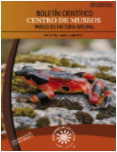Authors
Abstract
The Psittacidae family is one of the groups with the highest population decline due to hunting, habitat fragmentation and degradation. Conservation and reintroduction programs require the identification of gender in all individuals to perform kinship analysis, to estimate demographic parameters and to ensure that releases or reintroduction programs of individuals are more likely to succeed when releasing groups formed by males and females of reproductive age or established couples. Sex differentiation in psittacides presents difficulties due to the absence of sexual dimorphism and because sexing traditional methods are traumatic or require extensive protocols that do not work on juvenile individuals. In this sense, molecular and some cytogenetic tools are effective because they are not invasive and have a greater sensitivity. Both molecular and cytogenetic tools used in this study allowed differentiating between males and females of eight species of psittacines (Amazona amazonica, Amazona festiva, Amazona ochrocephala, Ara ararauna, Ara macao, Ara severa, Aratinga waglerii and Pionus menstruus). Generally speaking, efficiency of the PCR reaction to amplify genes CHD - Z and CHD - W for sampled individuals was 83% (34 of 41 individuals amplified). In a total of 32 individuals of six species of psittacines (Ara ararauna, Ara macao, Amazona festiva, Amazona ochrocephala, Pionus mentruus) the karyotype differentiation was possible in 25 of them representing a sensitivity of 78% for the cytogenetic sexing test. It was not possible to obtain a sufficient number of metaphases to establish the pattern of karyotype for Aratinga wagleri and Ara severa due to the low number of individuals. Psittacides sexing can be done by either of these two methods, although cytogenetic sexing is inconvenient for species that do not have a defined karyotype, as in the case of Ara severa and Aratinga wagleri. Molecular sexing provides a minimally invasive, effective and rapid technique to determine the sex of individuals using primers P2 and P8.
Keywords
References
BONAGURA, J. & KIRK, R., 1997.- Terapéutica veterinaria de pequeños animales. McGraw-Hill Interamericana.
CAMACHO, M.N., MARTÍN, N.R., DÍAZ, B.Z. & VERA, V., 2009.- Determinación del sexo en aves mediante herramientas moleculares. Actualidades Biológicas Colombianas, 14 (1): 25-38.
CAEIRO, A.M., 2015.- Sexado molecular en aves rapaces: Tesis, Facultad de Ciencias, Universidad de la Coruña, España.
CAPARROZ, R., ROBADO, N., BIANCHI, C. & WAYNTAL, A., 2001.- Analysis of the genetic variability and breeding behaviour of wild populations of two macaw species (Psittaciformes, Aves) by DNA fingerprinting. Ararajuba, 9 (1): 43-49.
CERIT, H.K., 2007.- Sex identification in avian species using DNA typing methods. World's Poultry Science Journal, 63: 91-99.
DUARTE, J.M.B. & CAPARROZ, R., 1995.- Cytotaxonomic analysis of Brazilian species of the genus Amazona (Psittacidae: Aves) and confirmation of the genus Salvatoria (Ribeiro, 1920). Rev. Bras. Genet., 18: 623-628.
DUBIEC, A. & ZAGALSKA, M., 2006.- Molecular techniques for sex identification in birds. Biological lett., 43 (1): 3-12.
DESCAILLEAUX, J., DESCAILLEAUX, L., ESTRADA, R., ESPINOZA, M., VELÁSQUEZ, M., VALENCIA, D., OLIVEIROS, N. & CORDOVA, J., 1979.- Manual de técnicas citogenética humana y de mamíferos. Universidad Nacional Mayor de San Marcos.
FRANCISCO, M.R. & GALETTI, J.R., 2001.- Citotaxonomic considerations on Neotropical Psittacidae birds and description of three new karyotipes. Hereditas, 134: 225-228.
FRIDOLFSSON, A.K. & ELLEGREN, H., 1999.- A simple and universal method for molecular sexing of nonratite birds. Journal of Avian Biology, 30: 116-121.
GOLDSCHMIDTT, B.M., DENISE, L. & SOUZA, M., 1997.- Chromosome study in two Aratinga species (A. guarouba and A. acuticaudata) (Psittaciformes). Brazilian Journal of Genetics, 20 (4).
GONZÁLEZ, S., 2014.- Determinación del sexo en aves: Tesis, Facultad de Ciencias, Universidad de la Coruña, España.
GRIFFITHS, R., 2000.- Sex identification of birds. Seminar in Avian an exotic Pet Medicine, 9 (1): 1-49.
GRIFFITHS, R. & TIWAR, B., 1995.- Sex identification of the last wild Spix's macaw. Nature, 375: 454-455.
GRIFFITHS, R., DOUBLE, M., ORR, K. & DAWSON, R., 1998.- A DNA test to sex most birds. Molecular ecology, 7: 1071-1075.
GRIFFITHS, R. & KORN, R., 1997.- A CHD1 gene Z chromosome linked in the chicken (Gallus domesticus). Gene, 197: 225-229.
HENAO, B.E. & MORENO, D., 2010.- Determinación molecular del sexo en siete especies de la familia Furnariidae - Aves: Tesis, Facultad de Ciencias Exactas, Universidad de Caldas, Manizales, Colombia.
JONES, A.G. & ANDREN, W.R., 2003.- Methods of parentage analysis in natural populations. Molecular ecology, 12: 2511-2523.
JUNIPER, T. & PARR, M., 1998.- Parrots: A guide to the parrots of the world. Pica Press.
LEDESMA, A.M., FREITAS, T.R., DA SILVA, J., DA SILVA, F. & GUNSKY, R.J., 2003.- Descripción Cariotípica de Spheniscus magellanicus (Spheniscidae). Hornero, 18 (1): 61-64.
LIZA, R.J., 2006.- Determinación del sexo en guacamayos de las especies Ara ararauna, Ara macao, Ara chroropthera, Ara militaris, Propyrrhura couloni mediante el uso de ADN: Tesis, Universidad de Quito, Ecuador.
LUCCA, E.J., SHIRLEY, L.R. & LAINER, C., 1991.- Karyotipe studies in twenty - two species of parrots (Psittaciformes: Aves). Rev. Brasil. Genetics, 14: 73-98.
MIYAKI, Y.M., GRIFFITHS, R., ORR, K., NAHUM, L.A., PEREIRA, S.L. & WAJNTAL, A., 1998.- Sex Identification of Parrots, Toucans and Curassows by PCR: Perspectives for Wild and Captive Population Studies. Zoo Biology, 17: 415-423.
OLIVEIRA, L.V., MERCIVAL, R.F., GUARACY, T., GOLDSCHMIDT, B. & GALETTI, P., 2003.- Karyotype description of two Neotropical Psittacidae species: The endangered Hyacinth macaw, Anodorhynchus hyacinthinus, and the Hawk-headed Parrot, Deroptyus accipitrinus (Psittaciformes: Aves), and its significance for conservation plans. Genetics and Molecular Biology, 26 (3): 283-287.
PAUTRAT, L., ANGULO, I., GERMANÁ, C., UCHIME, C., CASTILLO, R. & CANDELA, M., 2002.- Manual de identificación de especies peruanas de flora y fauna silvestres susceptibles al comercio ilegal. INRENA.
RODRÍGUEZ, J. & HERNÁNDEZ, J., 2002.- Loros de Colombia. Serie de Guías de Campo. Editorial Conservación Internacional Colombia.
WHITINGHAM, L.A. & DUNN, P.O., 2000.- Offspring sex ratios in tree swallows: Females in better condition produce more sons. Molecular Ecology, 9: 1123-1129.
ZÚÑIGA, C., RAMÍREZ, N., 2008.- Identificación del sexo en aves mediante la amplificación del gen CHD-1 por reacción en cadena de la polimerasa (PCR): Tesis, Facultad de Ciencias de la Salud, Universidad Colegio Mayor de Cundinamarca, Colombia.

 PDF (Español)
PDF (Español)
 FLIP
FLIP






















